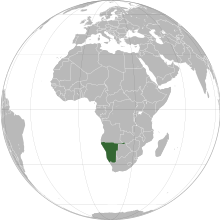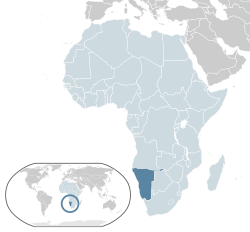
Back Намибиа Abkhazian Namibia ACE Намибие ADY Namibië Afrikaans Namibia ALS ናሚቢያ Amharic Namibia AMI Namibia AN Namibia ANG Namibia ANN
Republic of Namibia | |
|---|---|
| Motto: "Unity, Liberty, Justice" | |
| Anthem: "Namibia, Land of the Brave" | |
| Capital and largest city | Windhoek 22°34′S 17°5′E / 22.567°S 17.083°E |
| Official languages | English |
| Recognised national languages | |
| Recognised regional languages | |
| Ethnic groups (2023)[9] | |
| Religion (2023)[10] |
|
| Demonym(s) | Namibian |
| Government | Unitary dominant-party[11] semi-presidential republic[12] |
| Nangolo Mbumba | |
| Netumbo Nandi-Ndaitwah | |
| Saara Kuugongelwa | |
| John Mutorwa | |
| Peter Shivute | |
| Legislature | Parliament |
| National Council | |
| National Assembly | |
| Independence from South Africa | |
| 9 February 1990 | |
| 21 March 1990 | |
| Area | |
• Total | 825,615 km2 (318,772 sq mi) (34th) |
• Water (%) | negligible |
| Population | |
• 2025 census | 3,092,816[13] [9] |
• Density | 3.7/km2 (9.6/sq mi) (235th) |
| GDP (PPP) | 2023 estimate |
• Total | |
• Per capita | |
| GDP (nominal) | 2023 estimate |
• Total | |
• Per capita | |
| Gini (2015) | 59.1[15] high inequality |
| HDI (2022) | medium (142nd) |
| Currency | Namibian dollar (NAD) South African rand (ZAR) |
| Time zone | UTC+2 (CAT) |
| Date format | dd/mm/yyyy |
| Drives on | Left |
| Calling code | +264 |
| ISO 3166 code | NA |
| Internet TLD | .na |
Namibia (/nəˈmɪbiə/ ⓘ[17][18]), officially the Republic of Namibia, is a country in Southern Africa. Its western border is the Atlantic Ocean. It shares land borders with Angola and Zambia to the north, Botswana to the east and South Africa to the east and south. Although it does not border Zimbabwe, less than 200 metres (660 feet) of the Botswanan right bank of the Zambezi River separates the two countries. Its capital and largest city is Windhoek.
The driest country in sub-Saharan Africa,[19] Namibia has been inhabited since prehistoric times by the Khoi, San, Damara and Nama people. Around the 14th century, immigrating Bantu peoples arrived as part of the Bantu expansion. From 1600 the Ovambo formed kingdoms, such as Ondonga and Oukwanyama.[20]
In 1884, the German Empire established rule over most of the territory, forming a colony known as German South West Africa. Between 1904 and 1908, German troops waged a punitive campaign against the Herero and Nama which escalated into the first genocide of the 20th century. German rule ended during the First World War with a 1915 defeat by South African forces. (In 2021, German and Namibian diplomats created a "reconciliation agreement" acknowledging atrocities from the German colonial period.[21]) In 1920, after the end of the war, the League of Nations mandated administration of the colony to South Africa. From 1948, with the National Party elected to power, this included South Africa applying apartheid to what was then known as South West Africa.
In the later 20th century, uprisings and demands for political representation resulted in the United Nations assuming direct responsibility over the territory in 1966, but South Africa maintained de facto rule until 1973, when the UN recognised the South West Africa People's Organisation (SWAPO) as the official representative of the Namibian people. Namibia gained independence from South Africa on 21 March 1990, following the South African Border War. However, Walvis Bay and the Penguin Islands remained under South African control until 1994.
Namibia is a stable parliamentary democracy. Agriculture, tourism and the mining industry – including mining for gem diamonds, uranium, gold, silver and base metals – form the basis of its economy, while the manufacturing sector is comparatively small. Despite significant GDP growth since its independence,[22] poverty and inequality remain significant in the country. 40.9% of the population is affected by multidimensional poverty,[23] and more than 400,000 people continue to live in informal housing.[24] Income disparity in the country is one of the world's highest with a Gini coefficient of 59.1 in 2015.[25]
With a population of 2.8 million people, Namibia is one of the most sparsely populated countries in the world. Since the end of the Cold War, it has attracted notable immigration from Germany, Angola, and Zimbabwe.[26]
Namibia is a member state of the United Nations, the Southern African Development Community, the African Union and the Commonwealth of Nations.
- ^ "Communal Land Reform Act, German" (PDF). Government of Namibia. Retrieved 18 February 2016. [permanent dead link]
- ^ "Communal Land Reform Act, Afrikaans" (PDF). Government of Namibia. Archived from the original (PDF) on 25 February 2016. Retrieved 18 February 2016.
- ^ "Communal Land Reform Act, Khoekhoegowab" (PDF). Government of Namibia. Archived from the original (PDF) on 25 February 2016. Retrieved 18 February 2016.
- ^ "Communal Land Reform Act, Oshiwambo" (PDF). Government of Namibia. Archived from the original (PDF) on 1 March 2016. Retrieved 18 February 2016.
- ^ "Communal Land Reform Act, Otjiherero" (PDF). Government of Namibia. Retrieved 18 February 2016. [permanent dead link]
- ^ "Communal Land Reform Act, Rukwangali" (PDF). Government of Namibia. Archived from the original (PDF) on 25 February 2016. Retrieved 18 February 2016.
- ^ "Communal Land Reform Act, Setswana" (PDF). Government of Namibia. Archived from the original (PDF) on 25 February 2016. Retrieved 18 February 2016.
- ^ "Communal Land Reform Act, Lozi" (PDF). Government of Namibia. Archived from the original (PDF) on 25 February 2016. Retrieved 18 February 2016.
- ^ a b "Namibia 2023 Population and Housing Census Main Report" (PDF). Namibia Statistics Agency. Retrieved 30 October 2024. Cite error: The named reference "Census2023" was defined multiple times with different content (see the help page).
- ^ "Namibia Demographic and Health Survey 2013" (PDF). Namibia Ministry of Health and Social Services and ICF International. September 2014. p. 30. Archived (PDF) from the original on 18 June 2019. Retrieved 5 July 2021. Only people between 15 and 49 years of age were surveyed.
- ^ "The Management of a Dominant Political Party system with particular reference to Namibia" (PDF). Friedrich Ebert Stiftu. 10–12 December 2007. Retrieved 22 January 2025.
SWAPO Party being the dominant party in Namibia seized legitimate political power and thereby ending colonial rule on 21 March 2000. SWAPO Party's growth as dominant party was as follows…
- ^ Cite error: The named reference
Dualwas invoked but never defined (see the help page). - ^ "Namibia Population (2025) - Worldometer".
- ^ a b c d "World Economic Outlook Database, October 2023 (Namibia)". International Monetary Fund. 10 October 2023. Archived from the original on 29 October 2023. Retrieved 18 October 2023.
- ^ "GINI index (World Bank estimate)". World Bank. Archived from the original on 28 March 2019. Retrieved 20 January 2019.
- ^ "Human Development Report 2023/2024". United Nations Development Programme. 19 March 2024. Archived from the original on 19 March 2024. Retrieved 19 March 2024.
- ^ Wells, John C. (2008), Longman Pronunciation Dictionary (3rd ed.), Longman, ISBN 978-1405881180
- ^ Roach, Peter (2011), Cambridge English Pronouncing Dictionary (18th ed.), Cambridge: Cambridge University Press, ISBN 978-0521152532
- ^ Peter Shadbolt (24 October 2012). "Namibia country profile: moving on from a difficult past". CNN. Archived from the original on 20 February 2020. Retrieved 3 June 2018.
- ^ Williams, Frieda-Nela (1991). Precolonial Communities of Southwestern Africa: A history of Owambo Kingdoms 1600-1920 (PDF). National Archives of Namibia. Archived (PDF) from the original on 7 March 2024. Retrieved 7 March 2024.
- ^ Rogers, Thomas (9 March 2023). "The Long Shadow of German Colonialism". The New York Review of Books. Vol. 70, no. 4. ISSN 0028-7504. Retrieved 20 January 2025.
- ^ "World Bank Open Data". World Bank Open Data. Archived from the original on 3 April 2024. Retrieved 3 April 2024.
- ^ "Multidimensional Poverty Index 2023" (PDF). United Nations Development Programme Human Development Reports. 2023. Archived (PDF) from the original on 13 March 2024. Retrieved 3 April 2024.
- ^ "Namibia's ghetto life: Half million live in shacks countrywide – The Namibian". 12 March 2021. Archived from the original on 12 March 2021. Retrieved 3 April 2024.
- ^ "World Bank Open Data". World Bank Open Data. Archived from the original on 3 April 2024. Retrieved 3 April 2024.
- ^ "Migration to Namibia 1990-2017". Worldmapper. Retrieved 20 January 2025.
Cite error: There are <ref group=lower-alpha> tags or {{efn}} templates on this page, but the references will not show without a {{reflist|group=lower-alpha}} template or {{notelist}} template (see the help page).



